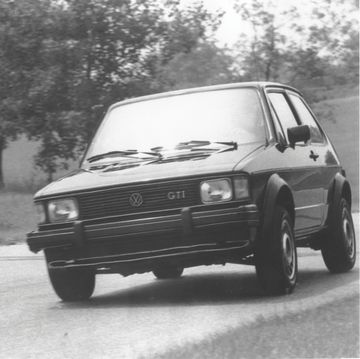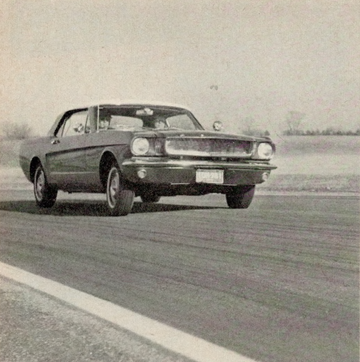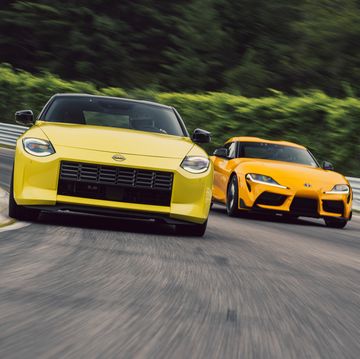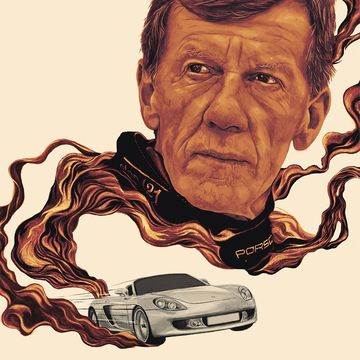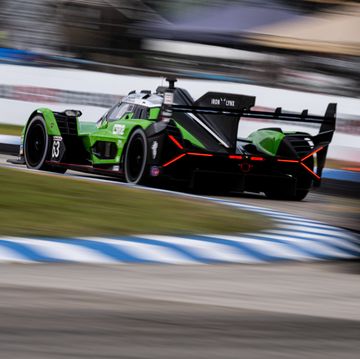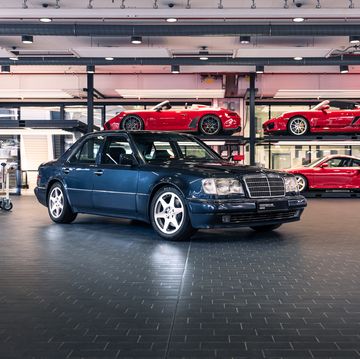"The runway next to this one," the man says, using the sheaf of remarkably comprehensive waivers that we've just signed to point behind us, "is active. Don't enter that runway. There's a $10,000 fine. And there will be aircraft using that runway during your test here."
No driving in front of airplanes, check. Cars on this runway, airplanes on that one. Check. Still, I momentarily contemplate defying the man: waiting for a Gulfstream to rotate into position on runway 33, then lining up next to it in the sleek Ferrari F12berlinetta or the stealth-creased new Corvette or the brutal Competition Pack BMW M6. Giving the universal signal: Let's go. Then the screech of tires and the roar of the turbofans, the asphalt rushing to the windshield, 5000 feet to the finish. Fist in the air, Top Gun-style. Childhood dreams are made of stuff like that.
I shake my head and look around: This is the stuff of childhood dreams. Thirteen cars, all new or significantly revised for 2013, from the ridiculously aggressive Mercedes-Benz SLS AMG Black Series to the sublime and elegant Jaguar F-type. Here's the plan: A full day thrashing around Detroit City Airport's runway 25 and its taxiways, otherwise known as the Motown Mile, to separate the brilliant from the merely good.
The top five will then be cleared for immediate departure to the hills of southeastern Ohio, where they'll be evaluated for real-world behavior and fast-road composure. There, among the blind apexes and decreasing-radius sweepers, we will crown our first Road & Track Performance Car of the Year.
The weather's on our side as the test begins: 55 degrees and clear skies. Our famously precise road test editor, Robin Warner, has come up with a characteristically exacting system to ensure that each of our nine drivers gets adequate and equal time in each of the cars. He hasn't said what the penalties are for ignoring his system, but it's safe to assume they would have made that Draco fellow weep. So we'll obey. The first car to attack the Motown Mile, therefore, will be A—for Audi R8 V10 Plus. The first driver will be B—for Baruth. Robin's there with his clipboard as I roll up to the start line. He looks extremely serious.
"When you enter the track, you will officially begin the first-ever R&T PCOTY." There's a moment of uncomfortable silence while I squeeze the R8's steering wheel a few times to relax. Then, finally, Robin smiles. "And that's kind of cool. Go, already!"
Here's the important thing to understand about the Motown Mile: It's not meant to be fun. It's meant to expose a car's weaknesses. So it doesn't "flow" or "lead the driver into the reward" or any of that Alan-Wilson-country-club-track business. It starts with a gut check, a fast kink into a dead-stop hairpin. Then two sharp slalom-style sections linked by a sweeper. Get out of that stuff and there's a 270-degree turn followed by the final problem, a right-hander onto the front straight. That has to be taken flat-out, no exceptions. Editor-in-Chief Larry Webster has put a cone on the inside of that corner, and I unceremoniously knock it out of the way while putting two wheels in the grass in search of a fast lap. I'll later find out the cone was there to keep me from hitting an expensive landing light.
Two laps around the Mile is enough to make it plain that the R8 won't make the cut. The Lamborghini-sourced V-10 seems to rev forever and the new twin-clutch gearbox is spectacular, but it feels like too much engine and weight for a car that's built for style, not speed. "I'm glad that Audi finally put a good automatic in this car," Associate Editor David Gluckman notes, "but I still don't want it. Rather have the six-speed manual and the V-8."
The BMW M6 Comp Pack can run within seven-tenths of a second of the R8 on-track, but it's not making friends. "Maybe in another group of cars this would stand out, but here, it's tepid," says Web Editor Alex Kierstein. Senior Editor Jason Cammisa, who is known to go into a kind of trance when describing the virtues of this car's sibling, the M6 Gran Coupe, can't muster any enthusiasm, either: "Far less feedback at the limit than I expect from an M car." The other BMW, the sleek 435i, is coming in for criticism as well, its log peppered with a surprising amount of indifference. One tester nails it: "Soft pedal, light steering, body roll ... what is this?"
Across the parking area, our pair of Jaguars is causing a commotion. The same supercharged V-8 and ZF eight-speed automatic appear in both, but the results are vastly different, and as we rotate through the cars there's a schism developing among our Jag lovers. "Bonkers chassis," raves Executive Editor Sam Smith, trailing his fingers indecently along the XFR-S's outrageous rear wing. "Crumpet."
"Fantastic car," Webster agrees. But the F-type has its defenders as well.
"Absolute hooligan," says Senior Editor Josh Condon. "Makes the Vette seem tame." Clearly, there's going to be a Jaguar in the top five. But which one?
We have a pair of small cars on hand—the Mini John Cooper Works GP and Ford Fiesta ST—and the editors are unanimously in favor of the Ford. Cammisa's notes in the JCW's logbook show him to be unimpressed: "Buh-bye, Mini, it's been fun. Disastrous on track." That might be a bit extreme, but I'm happy to step out of the Mini; it has a nasty habit of wagging its tail in 110-mph braking. "It's like they made it do that, for quote-unquote character," Webster suggests.
Character, the real stuff, is what the Fiesta has in spades. Nobody even bothers to suggest it won't come to Ohio. It's the slowest car here, but it never feels boring. "It isn't perfect," Gluckman argues, "but it's easily the most entertaining thing Ford's making right now."
There's a lot of chuckling in the paddock over the blue seats and odd Track Edition badging on Nissan's newest GT-R, but on the runway, it's serious business. It's also damn near the fastest car in the test. "It's so good ... and it used to be so terrible," says Cammisa. The low-speed understeer and clumsiness found in early versions of this car are gone, replaced by an all-singing, all-dancing sense of competence. But the Nissan's logbook is almost empty. It's quick, but it's not making an impression on most of us.
The Corvette, on the other hand, is making an impression on everyone. "The first Vette I've ever felt comfortable in," Gluckman enthuses. Not only is it faster and cheaper than the Cayman, nearly everybody (save for Cammisa) thinks it's closed the interior-quality gap to the Porsche. And the new seats are great. On the concrete course, it's both viciously quick and surprisingly manageable. We like the Cayman, but several of us are starting to love the not-so-big-anymore Chevrolet.
The initial consensus about the SLS AMG Black Series is that it needs to stay at the Motown Mile. It feels like a race car, in both the good and bad ways. Festooned with splitters, wings, and an exhaust that can be heard in the next ZIP code, the SLS is almost a parody of itself. The taller editors have to slouch painfully in the thing because there's no headroom, but they still want to drive it again. "Sounds like a dragon and a lion had a baby and you're steering from its mouth while it roars," laughs Condon.
That leaves the supercar and the station wagon. Turbocharging and all-wheel drive haven't done the formerly rear-drive E63 any favors. "Just not that hairy or thrilling," Smith pronounces, and all heads nod, except for Cammisa's. He's going on about the tossable nature of the thing. Nobody's buying it, even though we all saw him put the thing door-handles-to-the-cameras around the second-to-last turn on the track.
Time, at last, for the Ferrari. When I was a child visiting Disney World, I heard a rumor that there was a special room at the top of Cinderella's castle for exceptionally wealthy or lucky children. Not true: It was a storage area. But so many people heard the story that Disney finally decided to make it true. When the legend becomes necessary, build the legend.
Ferraris have never been quite as good, magical, or blindingly quick as their legend suggested. Until now. This big twelve-cylinder GT, the direct descendent of the 365 Daytona, does it all. It has the delicacy of an old F355 and the raw pace of an old F-104 Starfighter. Everything about this car has been relentlessly polished. It isn't until the second half of the course, as I'm offhandedly hanging the ass of the thing within a few inches of those very expensive landing lights, that I realize: This is truly a driver's car.
The F12berlinetta has a passenger-side LCD to show speed and gear information, and I happen to have a passenger, one of the airport employees. His eyes are fixed on the screen; it's less frightening than watching the car barrel toward a concrete barrier. I'd thought the big red coupe would be tough to hold flat through the kink, but it's exhilarating, not frightening. "How'd we do?" I ask.
"One thirty-eight," he responds, his eyes shut and neck straining against the g-loading of a brake-and-turn before the V-12 wakes up again and fires us, stutter-stepping, into the next right-hander. I can't lie: I was able to hit the same number in the GT-R, but in the Nissan it felt like unlocking an Xbox achievement. In the Ferrari, it felt like the climax of a Michael Bay film.
The end-of-day meeting, near a helicopter hangar still used by the Detroit police, is shorter than I'd expected. The Audi was the first car on track and it's also the first one to be cut: We love the R8, just not this R8. The 435i is next, with some dark muttering that the old 335i might have been a better choice to carry the roundel into combat. The M6 Comp? Fun to goon around in, but ultimately too big, too heavy, too sterile. Both Jaguars have their adherents, but the limited production and high price are sufficient to leave the XFR-S in the hangar. The Mini is rendered obsolete by the Fiesta. Nobody wants to drive the GT-R on the famously mad Ohio roads. And the E63 wagon has just one fan—Cammisa—who is shouted down.
Which leaves five: Corvette, Cayman, Fiesta, F-type, F12. But I have a problem with this. I really want to drive the SLS some more, so I tentatively suggest that we bring it along. Just in case, you know? I'm prepared to be shouted down as well, but to my surprise, I'm shouted up. And just like that, five become six. Time to head south.
Amazingly, the Midwest gives us great weather for the second day in a row. I'm in the passenger seat of the Cayman. Warner's behind the wheel, and I've decided to start my Ohio adventure by getting his impressions of the Porsche. He's not pleased. "Compared to a 987, it disappoints ... steering load doesn't vibe with actual remaining grip, and it doesn't speak to me like the old one did." As the road rises and falls across the Hocking Hills, I watch Warner steer for the turn, then check visually, then adjust, then check again. His pace is solid, but he's frowning.
Just as I'm ready to consign the Cayman to last place, I talk to Kierstein, who's a fan. "If someone told me I had to choose one of the PCOTY finalists for a run from New York to L.A.," he says, "and it was all winding back roads and actual city driving, without question, it'd be the Porsche." He has a point, and I'm in the process of reevaluating the car when the call comes on my hand-held radio: "The Ferrari's dead."
Well, it's not quite dead. But as we round the corner, we see it's in limp mode, with all dashboard lights flashing and a maximum speed of 35 mph. For the next hour, we try rebooting it in various fashions—door and ignition cycling, relay pulling, battery disconnect—to no avail. Our six have become five again. It's a shame, but to finish first, as they say, you must first finish.
Seeing the Vette parked next to the disabled Ferrari is amusing; they really look quite alike. Thankfully, the C7's virtues elevate its sharp-edged looks to tribute, not parody. Warner adores the car: "Hearing the motor under load reminds me more of AMG than Chevy small-block. Brilliant! Loving this." I sit in with the man for a few miles and watch him enjoy the Stingray, reveling in the steering feedback and the visibility and the almost-a-Z06 power.
It sounds melodramatic, but virtually all of our drivers agree: The C7 isn't just a Corvette. Since the early days of the Cross-Fire C4, 30 years ago, the plastic Chevy's been a racetrack wonder and a twisty-road chore. It's been a numbers car, beloved of the stopwatch but frequently consigned to the garage when it's time to focus on enjoyment. This new one? It's something else. The seats, finally, are good enough for long trips. The roof is easy to remove and store. It's become a brilliant everyday car.
Surprisingly, the "hard-core" SLS is also capable of charming us on the back roads of Ohio. The Mercedes is rumored to share some of its chassis and development with the Dodge Viper, but out here, it feels half as wide and half as long as its maybe-brother from another mother. I ride with a few of the other editors and notice they're occasionally brushing the soft shoulder clean with the car's massive Pilot Sport Cups, but the SLS is manageable enough. And still fast. Oh, so fast; it can touch escape velocity in the shortest gap between turns, the peerless transmission banging across gears with a vicious snort. It's 300 grand, so it should be perfect, but as Condon notes, "It's so much better than most cars that also cost a stupid amount of money."
Time to jump into the F-type with Smith. "I suppose it could go faster, could be pushed harder," he muses, as small branches blow off trees in our wake. "But I just don't want to. The faster you go, the bigger the car feels. It was better on the track, a slide machine." In truth, I'm wondering if we brought the wrong Jag. The brakes on this one are pretty soft after repeated use, and the car never manages to just flow through a section of road. It's point and shoot, a speedboat bullying its way across the landscape.
After everyone's rotated through the cars once, there's a sort of rush to claim the Stingray at each driver swap, but the Fiesta's also drawing its share of repeat offenders. Condon's a fan: "The whole thing feels like they built the car around you—a totally connected blast. Pound-for-pound champ." Better check it out, then.
The Ford had seemed competent enough on the track, but on the road, it's a revelation. It's full throttle everywhere and trail-brake and body roll and just thrilling. "You wouldn't want to go any faster on these roads than the Fiesta can go," Cammisa says. It's a rare moment of sanity from our in-house drift-master, but he has a point. There's enough brake, enough power, enough grip. Smith notes that it has roughly the power-to-weight ratio of an E30-chassis BMW M3, and it shares that car's appetite for the road—if you can't go fast in the Fiesta, you can't go fast.
Decision Time
It would be easy to say that all five of these cars are winners, but let's be real. Only one of them can be. First to drop off the radar is the clinical Cayman. Sounds great, looks great, but in the final voting, it had no friends. Same goes, sadly, for the F-type. On the track, it was great fun, but in the cross-country crucible it went soft and a bit sketchy.
And then there were three. The Fiesta ST is recommended without reservation. As a dynamic proposition in the real world, it is without peer. Were this magazine named simply Road, it would have the Fiesta ST on the cover six times a year. On the track, however, the ST is outgunned. You'd never get sick of the steering or the balance, but at a track day, you'd get sick of having your point-by hand out the window for every straight. Third place, with honors.
The SLS Black Series is utterly, fearlessly, completely brilliant. It succeeds on every level. It makes the girls at the McDonald's window swoon, and it causes children to run across busy streets just to touch the wing. As a track weapon, it delivers an intense, fully realized, GT3-car-with-license-plates experience. It's the only self-shifting car here that doesn't feel compromised from lack of a clutch pedal. Yet it works perfectly well as a road car. Its limits, though sky-high, can be reached if you have the courage. It's a high-water mark in flash, capability, and delight. And, unfortunately, price.
Come dinnertime, when the voting and arguments started, it was apparent that we had a problem. Slightly more than half of us immediately chose the Corvette. Yes, it's fast, as you'd expect. Yes, it makes short work of straights and develops massive grip, even where the pavement is broken or the deep shade leaves pools of old rainwater to splash and steam from the brakes. But it's now the complete package. There are no longer any excuses.
Yet there was a stubborn minority holding out for the AMG, regardless of cost. It's the car of our dreams in many respects. Shouldn't it be PCOTY, even if most of us will never see one on the street? "If we're going to pick the Vette because of cost," one editor snapped, "why not go all the way and pick the Fiesta? It's the best value."
To answer that, I thought about my final drive in the Corvette, down the vicious, dark side of a steep hill. The C7 may not have the flash of the Black Series, and it might not be as affordable as the Fiesta, but down a difficult road or around an open track, it has virtually all of the former's pace with the accessible brilliance of the latter. You can use full throttle, you can use the brakes. You can use the C7, but you won't use it up. It's the most capability that any manufacturer has ever delivered for this money, it's rewarding to drive for everyone from novice to seasoned racer, and it is, definitely and deservedly, the Road & Track Performance Car of the Year.
R & T OFFICIAL TEST RESULTS
Jack Baruth is a writer and competitor who has earned podiums in more than fifteen different classes and sanctions of automotive and cycling competition, in both amateur and professional capacities, as well as an enthusiastic hobbyist musician and audiophile who owns hundreds of musical instruments and audio systems. His work has appeared in Bicycling, Cycle World, Road & Track, WIRED, Wheels Weekly, EVO Malaysia, Esquire, and many other publications. His original design for a guitar, the Melody Burner, has been played by Billy Gibbons, Sheryl Crow, and others.





